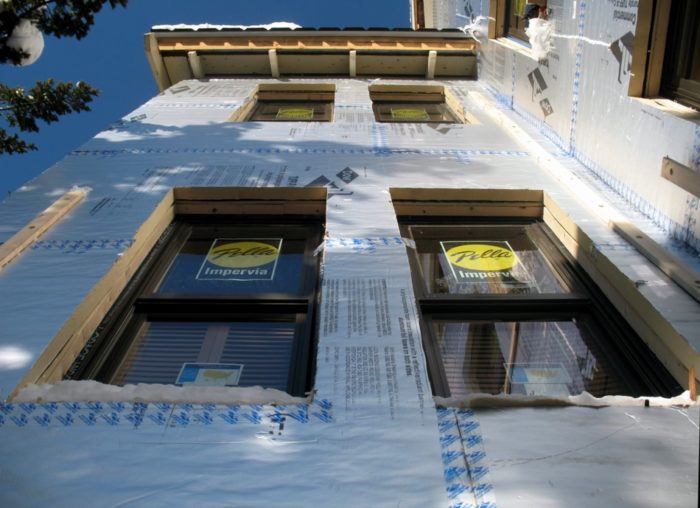
Image Credit: GreenBuildingAdvisor.com
Homes adjacent to demolished rowhouses in Philadelphia are left with more exposure to cold and heat. But three local professors collaborated on a solution
There are certain efficiencies inherent in rowhouses, not the least of which is that their common sidewalls limit extreme-weather exposure largely to the front and back of each house.
Noise sometimes leaks through the walls, but rowhouse living generally is fairly comfortable and energy efficient for city dwellers. Unless, of course, the rowhouse next to yours is razed.
As a recent story in the Philadelphia Inquirer notes, that is one of the unintended consequences of an initiative launched several years ago by the administration of John F. Street, who served as mayor of Philadelphia from January 2000 to January 2008. Designed to further neighborhood revitalization, the program included tear-downs of derelict rowhouses but didn’t anticipate the tear-downs’ effect on the homes of adjacent neighbors, who were suddenly faced with increased sidewall exposure to heat and cold, and the added expenses that go with it.
Maintaining Philly’s reputation for invention
The occupants of many of the remaining rowhouses are “people who really can’t afford” to pay more to be comfortable, Fredda Lippes, an architect and also the city’s sustainability manager, told the paper. So Lippes and other city officials contracted Philadelphia University to find a solution, which, according to the Inquirer, now appears to be “just a few safety tests away” from being implemented.
Three of Philadelphia University faculty members – engineering professor Chris Pastore; Robert Fleming, an associate professor in architecture; and Tom Twardowski, a chemical engineer – developed a product that consists of layers of insulating foam, high-density foam, fabric (to prevent penetration of sharp objects), and a latex-stucco finish. The material is durable and aesthetically appealing, its developers say.
The plan is to produce this sheathing in 2×4 panels that can be affixed to an exterior wall with foaming adhesive. The university was awarded a patent for the product, called Exolation, last month.
A potential bonus for the city, if the testing goes as hoped and officials can find a local company to make the sheathing, is that Exolation’s manufacture will create jobs for Philadelphia. So far so good. In two tests, the Inquirer points out, crews of three were able to cover an entire rowhouse wall in four hours or less.
Another potential positive is that Exolation installations could help Philadelphia maintain its existing stock of rowhouses, which shape the character of much of the city. The town’s interest in preserving these homes is such that, as part of the city’s participation in the National Trust for Historic Preservation’s Preservation Development Initiative, Philadelphia published a 52-page document on rowhouse preservation titled “Philadelphia Rowhouse Manual: A Practical Guide for Homeowners.”
To say the least, city officials seem excited by Exolation’s prospects, and take particular pride in the fact that it is a product of local innovation.
“In our city, [invention is] a tradition as old as Ben Franklin,” said Mark Alan Hughes, policy adviser to the current mayor, Michael Nutter. “Need fire insurance? Invent the fire insurance company. Need to make that company more profitable? Invent the lightning rod. Need a way to bring the benefits of insulation to rowhouses that have lost a neighbor? Invent Exolation.”
Weekly Newsletter
Get building science and energy efficiency advice, plus special offers, in your inbox.










0 Comments
Log in or create an account to post a comment.
Sign up Log in